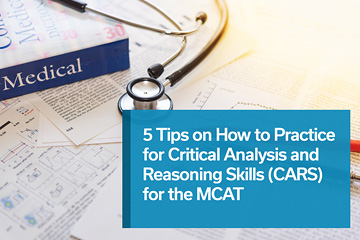
5 Tips on How to Practice for Critical Analysis and Reasoning Skills (CARS) for the MCAT
CARS is one of the sections of the MCAT that is often dreaded by pre-med students. The large, and seemingly random, scope of topics combined with a significant time crunch make tackling the section one of the more challenging tasks for MCAT-takers. Fortunately, CARS is something that anyone can improve on with practice and a bit of advice.
#1 – Practice early and consistently
Practicing for CARS is not something most people can procrastinate and then cram in the last few weeks. I know several people who left CARS practice to the last minute and unfortunately struggled in the section. It takes an enormous amount of time to build up the analytical skills and to develop a well-timed strategy. My advice is to start practicing with a few passages a day to get an idea of what kinds of topics might be tested, to play around with a few strategies for reading (e.g. whether or not to highlight), and to start thinking about time management. Later on, you can start to get a sense of the patterns of questions that are being asked (e.g. what is the author arguing for/against? What is their tone? What inferences can we draw?).
#2 – Fully read the passage first before going to the questions
I recommend reading the passage fully before going to the questions, rather than skimming the passage or looking at the questions first. Time is definitely a huge issue in CARS, and often people will stumble trying to skim as quickly as they can or to tackle the questions first before reading. Although it can save time, this runs the risk of missing important details and the context of what the author is trying to portray. Looking at the questions first also might bias you and lead you to read with a certain perspective, instead of understanding what the author is truly saying.
#3 – Avoid extremes and absolutes
When there are options to a question that tend toward the extreme or absolutes, they are usually incorrect. These options can act as a trap as well if you bring outside information that you know is correct. Remember that the information in the passage is what you should be drawing on to inform your answer.
#4 – Practice reading long passages on difficult topics
Most of us are intimidated by lengthy, complex passages about random topics that we’ve never encountered. The important thing to remember is that you aren’t expected to know details about most of these topics beforehand, but rather you are expected to study the information that is given. In a way, this is a double-edged sword: there aren’t any discrete topics you need to study for CARS, but it also means you can’t memorize your way through CARS. As a result, when I was practicing for CARS, I made sure to choose the longest passages I could find about the topics that I felt the least comfortable with. To do so, I used Jack Westin passages and focused more so on getting through the passages and questions within the allotted time rather than focusing on the logic of the answers (more about that below).
#5 – Use AAMC material
To MCAT veterans, it is no secret that the AAMC is the gold standard to practice with. This is especially true for the CARS passages. I recommend buying the CARS question packs and working your way through them, really focusing on the logic of the answers. There are several third-party companies that can provide questions, but AAMC is, of course, the most aligned with what you will see on the actual exam. As a result, don’t rush through the material, but rather integrate it throughout your MCAT studying. Don’t feel disheartened if you don’t do as well as you would have liked – the question packs are notorious for being difficult.






